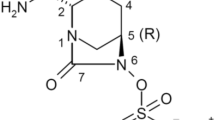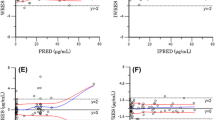Summary
A prominent trend in optimising anti-infective therapy is to prescribe time-dependent antibacterials (e.g. β-lactams, glycopeptides) using short dosing intervals, but to prescribe concentration-dependent antibacterials (e.g. aminoglycosides, quinolones) using widely spaced intervals — even once daily. However, the currently prevailing notion that the clinical efficacy of concentration-dependent antibacterials can be improved by lengthening the dosing interval has not been well established. We integrated the differential equations of a pharmacokinetic/pharmacodynamic model describing the fate of a bacterial population in the presence of an antibacterial agent. We studied the variations of predicted efficacy, using a 1-compartment pharmacokinetic model with intravenous administration, according to the ratio between the dosing interval and the half-life of the drug, for a given daily dose. Simulations were performed using the published in vitro killing curve data of Pseudomonas aeruginosa obtained with tobramycin and ticarcillin. The results suggest that, independent of the time- or concentration-dependent nature of the antibacterial agent and the susceptibility of the pathogen, steady-state efficacy will decrease as the dosing interval increases, and therefore all antibacterials should ideally be administered at relatively short dosing intervals compared with their half-life, so that concentrations are below the minimum inhibitory concentration (MIC) as little as possible. Some arguments support the use of a large loading dose for concentration-dependent antibacterials, to rapidly reach steady-state at the infection site (this is also valid for time-dependent antibacterials), and to avoid the emergence of resistant mutants. Aminoglycosides are a special case within the class of concentration-dependent antibacterials, because of the possibility of adaptive resistance in terms of efficacy and of saturable target-organ uptake in terms of toxicity, both of which may support the concept of a long administration interval for these agents. Widely spaced administration of large doses of antibacterials with little dose-dependent toxicity may remain a valuable option, for reasons of cost and convenience, in the case of high susceptibility of the pathogen. However, in difficult situations (e.g. short drug half-life, high MIC of the pathogen, compromised host defences), optimising therapy using short dosing intervals should be most beneficial, especially when both the dose and the dose interval are adjusted for each patient (bodyweight, renal function, etc.) to achieve and maintain specific peak and trough concentrations selected according to the infecting organism and its susceptibility to the drug.
Similar content being viewed by others
References
Ebert SC, Craig WA. Pharmacodynamic properties of antibiotics: application to drug monitoring and dosage regimen design. Infect Control Hosp Epidemiol 1990; 6: 319–26
Craig WA, Ebert SC. Killing and regrowth of bacteria in vitro: a review. Scand J Infect Dis 1991; Suppl. 74: 63–70
Bergan T, Carlsen IB. Bacterial kill rates of amoxycillin and ampicillin at exponentially diminishing concentrations simulating in vivo conditions. Infection 1980; 8 Suppl. 1: 103S–8S
Shah PM, Ghahremani M, Gorres FJ, et al. Bactericidal activity of antimicrobials in the dynamic kill-curve model. J Drug Develop 1988; 1 Suppl. 3: 35–47
Garrett ER. Kinetics of antimicrobials action. Scand J Infect Dis 1978; 14: 54–85
Navashin SM, Fomina IP, Firsov AA, et al. A dynamic model for in vitro evaluation of antimicrobial action by simulation of the pharmacokinetic profiles of antibiotics. J Antimicrob Chemother 1989; 23: 389–99
Briceland LL, Pasko MT, Mylotte JM. Serum bacterial rate as a measure of antibiotic interactions. Antimicrob Agents Chemother 1987; 31: 679–85
Tisdale JE, Pasko MT, Mylotte JM. Antipseudomonal activity of simulated infusions of gentamicin alone or with piperacillin assessed by serum bactericidal rate and area under the killing curve. Antimicrob Agents Chemother 1989; 33: 1500–5
Drusano GL. Human pharmacodynamics of beta-lactams, aminoglycosides and their combination. Scand J Infect Dis 1991; Suppl. 74: 235–48
Zhi J, Nightingale CH, Quintiliani R. Microbial pharmacodynamics of piperacillin in neutropenic mice with systemic infection due to Pseudomonas aeruginosa. J Pharmacokinet Biopharm 1988; 16: 355–75
Mentré F. Analyse de la relation dose-effet par les modèles de population. In: Chastang C, Pons G, Regnier B, editors. Méthodes nouvelles en pharmacologie clinique pédiatrique. Paris: Springer-Verlag, 1992: 69–88
Blaser J, Stone BB, Zinner SH. Efficacy of intermittent versus continuous administration of netilmicin in a two-compartment in vitro model. Antimicrob Agents Chemother 1985; 27: 343–9
Blaser J, Stone BB, Groner MC, et al. Comparative study with enoxacin and netilmicin in a pharmacodynamic model to determine importance of ratio of antibiotic peak concentration to MIC for bactericidal activity and emergence of resistance. Antimicrob Agents Chemother 1987; 31: 1054–60
Gerber AU, Wiprächtiger P, Stettier-Spichiger U, et al. Constant infusions vs. intermittent doses of gentamicin against Pseudomonas aeruginosa in vitro. J Infect Dis 1982; 145: 554–60
Vogelman BS, Craig WA. Postantibiotic effects. J Antimicrob Chemother 1985; 15 Suppl. A: 37–46
Leggett JE, Ebert S, Fantin B, et al. Comparative dose-effect relations at several dosing intervals for beta-lactams, aminoglycoside and quinolone antibiotics against Gram-negative bacilli in murine thigh-infection and pneumonitis models. Scand J Infect Dis 1991; Suppl. 74: 179–84
Giuliano RA, Verpooten GA, Verbist L, et al. In vivo uptake kinetics of aminoglycosides in the kidney cortex of rats. J Pharmacol Exp Ther 1986; 236: 470–5
Verpooten GA, Giuliano RA, Verbist L, et al. Once-daily dosing decreases renal accumulation of gentamicin and netilmicin. Clin Pharmacol Ther 1989; 45: 22–7
Mattie H, Craig WA, Péchère JC. Determinants of efficacy and toxicity of aminoglycosides. J Antimicrob Chemother 1989; 24: 281–93
Barclay ML, Begg EJ, Hickling KG. What is the evidence for once-daily aminoglycoside therapy? Clin Pharmacokinet 1994; 27: 32–48
Zhanel GG, Craig WA. Pharmacokinetic contributions to postantibiotic effects. Focus on aminoglycosides. Clin Pharmacokinet 1994; 27: 377–92
Daikos GL, Jackson GG, Lolans VT, et al. Adaptive resistance to aminoglycoside antibiotics from first exposure down-regulation. J Infect Dis 1990; 162: 414–20
Daikos GL, Lolans VT, Jackson GG. First-exposure adaptive resistance to aminoglycoside antibiotics in vivo with meaning for optimal clinical use. Antimicrob Agents Chemother 1991; 35: 117–23
Author information
Authors and Affiliations
Rights and permissions
About this article
Cite this article
Bouvier d’Yvoire, M.J.Y., Maire, P.H. Dosage Regimens of Antibacterials. Clin. Drug Invest. 11, 229–239 (1996). https://doi.org/10.2165/00044011-199611040-00006
Published:
Issue Date:
DOI: https://doi.org/10.2165/00044011-199611040-00006




